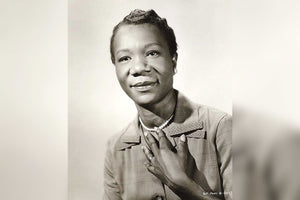Birthday: January 16, 1816
Who was Frances Browne?
Frances Browne was a celebrated Irish poet, short-story writer, journalist, and novelist, renowned for her magical children’s stories.
Her most famous work was Granny’s Wonderful Chair (1856). In this magical chair, a little girl called Snowflower could be transported wherever she wished by saying “Chair of my grandmother, take me to…”.
Top five facts
- Frances was a literary celebrity in her day and was known as “The Blind Poetess of Ulster.”
- She lost her sight and became blind when she was only 18 months due to smallpox, even though the vaccine had already been discovered.
- Frances didn’t go to school but had a phenomenal memory: she knew whole books off by heart. She bribed her brothers and sisters to tell her about their lessons by telling them stories!
- “Granny’s Wonderful Chair” is still in print today and has been translated into several different languages.
- She composed her first poem at the age of seven, which was her very own version of The Lord’s Prayer!
Frances Browne’s Most Famous Quotes
“Ye treasure each voice of the swift passing ages”
“…a clear voice from under the velvet cushion began a new and most wonderful tale, which surprised Snowflower so much that she forgot to be afraid. After that the good girl was lonely no more.”
Frances’s Family Background
Frances was born in Stranorlar, County Donegal, Ireland. She was born the seventh child in a family of twelve. When she was only 18 months old, she she lost her sight and became completely blind due to an outbreak of smallpox. She never regained her sight.
Frances’s Education
In those days, blind people did not go to school, so her brothers and sisters would read aloud to her, and she would later memorize everything by heart. Frances would also persuade her siblings to read to her by offering to do their house chores!
Career
In 1841, at the age of 25, Frances was delighted to see her first poems published in the London Athenaeum. Her most famous poem, ‘Songs of Our Land’ was also published in the Irish Penny Journal. Newspapers reprinted her poems until she became widely known as ‘The Blind Poetess of Ulster.’
In 1844, her first complete volume of poems, The Star of Atteghei was published by the same publishing body as Shelley, Wordsworth, and Tennyson!
In the year of the Great Famine, 1847, Frances’ father died. Frances then decided to take the bold and courageous step of moving to Edinburgh to launch her literary career. Her sister, Rebekah, went with her as her amanuensis (her ‘eyes and ears’).
Frances became well-known in literary circles in Edinburgh and made over 100 contributions to the Athenaeum! She also published more books, including the famous Twelve Legends of Ulster. Inspired, Frances took another brave step, hoping for even greater success. She moved to London!!
In London, Frances began writing for various newspapers, and all was well until Rebekah announced that she was marrying an engineer and moving to Scotland. Frances was heartbroken. It was during this time that she wrote and published her best-known work: Granny’s Wonderful Chair and its Tales of Fairy Times, a collection of rich and imaginative fairytales that solidified her reputation as an established author. It became an international bestseller.
Her work came to the attention of Lord Landsdowne, who, hearing that she was in financial difficulty, sent her a cheque for £100, a large sum of money in those days. She also received a small civil pension for her work, but despite this, Frances was very poor for most of her life.
In 1856, she published her third volume of poetry entitled Pictures and Songs of Home. It had beautiful and imaginative illustrations paired with vivid descriptions that represented her childhood in County Donegal and its beautiful countryside.
Frances also wrote the first of her several published novels: My Share of the World. By 1866, she had published 178 articles in periodicals, 109 individually published poems and 78 works of periodical fiction, including 16 serials.
In 1867, Frances was declared bankrupt and left London to move to Richmond, where she continued to write. Her last poem, ‘The Children’s Day,’ was published in The Sunday at Home in 1879.
Legacy
Some of the most notable figures in the literary world loved her work, including Frances Hodgson Burnett, who modelled The Secret Garden on Granny’s Wonderful Chair.
Frances’s story is an inspiration to all. She defied the odds by being one of the best during her time as a poet, novelist, and outstanding storyteller. Even though Frances was blind, she could see more than most sighted people. This was because of her imagination. Her mind and her heart were strong and she never gave up.
![]() Fast Shipping
Fast Shipping![]() Subscribe to our Newsletter
Subscribe to our Newsletter![]() 🌟 New Global Competition 🌟
🌟 New Global Competition 🌟














